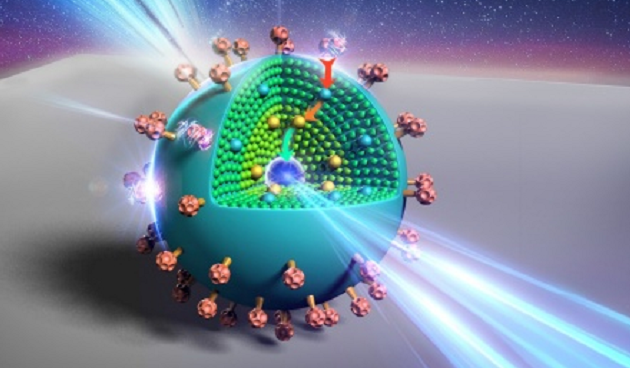
An innovative onion-like nanoparticle has been developed that can efficiently convert low energy near-infrared radiation into UV light of a higher energy. The process involves the transfer of the infrared photons energy into the nanoparticle core, where they are fused together to form one, higher-energy photon.
Measuring approximately 50nm in diameter, the new nanoparticle features three differently designed layers. Together, these three layers facilitate the efficient conversion of near-infrared light into higher energy UV light. These layers consist of an organic dye coating, a neodymium shell and a core of thulium and ytterbium.
The new onion-like nanoparticle could redefine light-based bioimaging,security methods and solar energy harvesting techniques.
Light-emitting nanoparticles within the human body can be stimulated by near-infrared light for use in bioimaging. High-contrast images of targeted areas of the body can be achieved.
For security applications, inks infused with nanoparticles could be integrated into currency designs. Whilst these types of ink cannot be seen with the naked eye they emit blue light when they are bombarded with a low-energy laser pulse, allowing the ink to be observed. As the production of the nanoparticles is complex this would be difficult to forge.
It opens up multiple possibilities for the future
Tymish Ohulchanskyy - University at Buffalo
By creating special layers that help transfer energy efficiently from the surface of the particle to the core, which emits blue and UV light, our design helps overcome some of the long-standing obstacles that previous technologies faced
Prof. Guanying Chen - Harbin Institute of Technology
It is difficult to convert low-energy light into higher energy light, a process known as 'upconversion'. This is because to achieve this, two or more photons have to be captured from a low-energy light source and then their energies have to be integrated to produce one higher-energy photon.
However, using the new nanoparticle this job can be easily accomplished. This is achieved because each uniquely designed layer displays the optimum behaviour for it's role..
Our particle is about 100 times more efficient at ‘upconverting’ light than similar nanoparticles created in the past, making it much more practical.
Tymish Ohulchanskyy - University at Buffalo
The organic dye coating, which forms the outermost layer, serves as an antenna for the nanoparticle. It absorbs and harvests photons from the near-infrared region and transfers it's energy into the particles core.
A neodymium-containing shell forms the second layer, which facilitates the transfer of energy from the dye to the light-emitting core of the nanoparticle.
Within the particle’s light-emitting core, thulium ions and ytterbium ions work in tandem to convert energy into UV light. Ytterbium ions transfer the energy from the neodymium shell and pass it to the thulium ions. Thulium ions display unique behaviour which allows them to simultaineously absorb the energy of three or more photons. By combing multiple low energy photons the thulium ions can produce one higher-energy UV photon.
Considering that the core itself is also capable of photon absorption, the use of both neodymium and dye layers appears to be unnecessary. However, by itself the core is not an efficient absorber and needs the dye to achieve a high-enough throughput. The dye itself is also not capable of efficient energy transfer, which is why the neodymium shell, that lies inbetween the core and the outer dye layer, is required
This concept can be explained using a staircase as an example;
When a photon is absorbed by matter, the matter becomes excited and transfers this energy to other ions or molecules. It has been shown that the most efficient transfer takes place between matter which require similar quantities of energy to be excited. However, the ytterbium ions and dye require different amounts of energies to enter their excited states. Neodymium forms the middle layer as the energy of its excited state is inbetween the energies of the excited states of the core thulium ions and the dye. Effectively, the neodymium serves as a bridge between the excited states of the outer and inner layers.
The three excited states form a 'staircase', allowing the energy to be passed through the nanoparticle to reach the thulium ions.